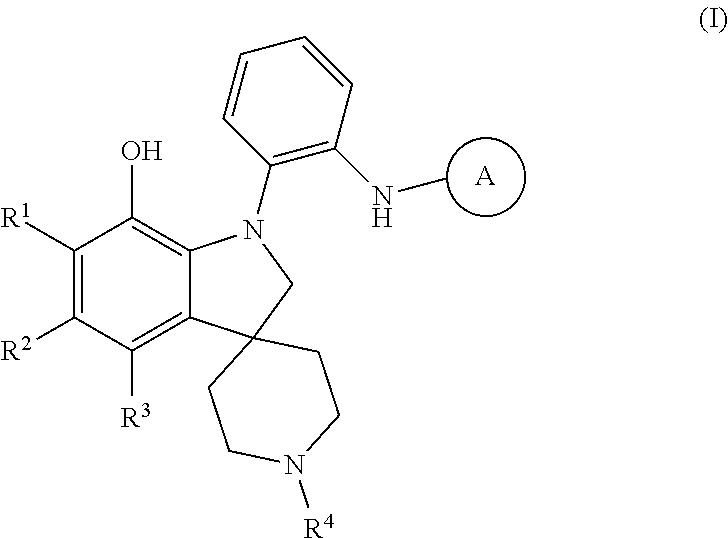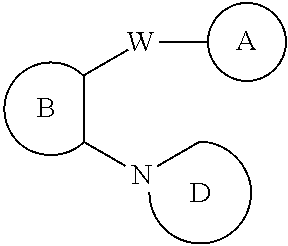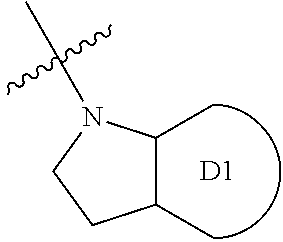Amino-heteroaryl 7-hydroxy-spiropiperidine indolinyl antagonists of p2y1 receptor
- Summary
- Abstract
- Description
- Claims
- Application Information
AI Technical Summary
Benefits of technology
Problems solved by technology
Method used
Image
Examples
example 1a
[0283]1-(2-Isothiocyanatophenyl)-7-methoxy-1′-neopentyl-4-(trifluoromethyl)spiro [indoline-3,4′-piperidine]: To a solution of Intermediate 3 (1.29 g, 2.88 mmol) in dichloromethane (10 mL) was added 1,1′-thiocarbonyldipyridin-2(1H)-one (0.669 g, 2.88 mmol) in dichloromethane (15 mL) dropwise over 20 min. The reaction temperature was stirred at 23° C. for 5 h. The reaction was concentrated and purified by flash chromatography (silica gel, eluting with EtOAc / Hexanes) to give Example 1A as a white solid (1.36 g, 2.78 mmol, 96.0% yield). LC-MS ESI 490.5 (M+H) (Method A, RT=3.26 min). 1H NMR (400 MHz, chloroform-d) δ ppm 7.23 (1H, d, J=7.20 Hz), 7.20 (1H, dd, J=7.83, 1.52 Hz), 7.12 (1H, t, J=7.20 Hz), 7.03 (1H, t, J=7.33 Hz), 6.88 (1H, d, J=7.83 Hz), 6.76 (1H, d, J=8.59 Hz), 4.08 (1H, d, J=10.11 Hz), 3.69 (1H, d, J=10.11 Hz), 3.62 (3H, s), 2.76 (1H, s), 2.68 (1H, s), 2.44 (1H, d, J=1.77 Hz), 2.41 (1H, s), 2.03 (2H, s), 1.68 (1H, s), 1.58 (1H, s), 1.41 (1H, d, J=9.09 Hz), 1.23-1.28 (1H, m)...
example 1b
[0284]N-(2-(7-Methoxy-1′-neopentyl-4-(trifluoromethyl)spiro[indoline-3,4′-piperidine]-1-yl)phenyl)-5-phenyl-1,3,4-thiadiazol-2-amine: A solution of Example 1A (104 mg, 0.212 mmol) and benzohydrazide (28.9 mg, 0.212 mmol) in dichloromethane (1 mL) were stirred at 23° C. for 18 h. Conc. sulfuric acid (0.226 mL, 4.25 mmol) was added dropwise. After 30 min, the reaction mixture was quenched with saturated NaHCO3, extracted with dichloromethane (2 mL×3), concentrated, and purified by flash chromatography (silica gel, eluting with EtOAc / Hexanes) to give Example 1B as a white solid (70.0 mg, 0.115 mmol, 54.2% yield). LC-MS ESI 608.6 (M+H) (Method A, RT=3.29 min). 1H NMR (400 MHz, chloroform-d) δ ppm 7.90 (1H, d, J=8.35 Hz), 7.84-7.87 (2H, m), 7.41-7.45 (3H, m), 7.21-7.26 (2H, m), 6.99 (2H, d, J=3.95 Hz), 6.72 (1H, d, J=8.79 Hz), 4.03 (1H, d, J=10.11 Hz), 3.51 (3H, s), 3.32 (1H, d, J=10.11 Hz), 2.77 (1H, s), 2.72 (1H, s), 2.60 (2H, t, J=12.96 Hz), 2.32 (2H, t, J=12.30 Hz), 2.07 (2H, s), 1.6...
example 1
[0285]To Example 1B (70 mg, 0.115 mmol) and tetrabutylammonium iodide (255 mg, 0.691 mmol) in dry DCM (1 mL) under argon at −50° C., boron trichloride in 1 N dichloromethane solution (0.576 mL, 0.576 mmol) was added dropwise. The stirring mixture was stirred from −50 to −10° C. over 1 h, and then dry ice bath was removed. The mixture was stirred at 23° C. for 18 h. At 0° C., water (0.5 mL) was added dropwise. The reaction mixture was extracted with dichloromethane (2 mL×3). The organic layers was combined, concentrated, and purified by prep HPLC (9-54% acetonitrile in water over 20 min, 0.1% TFA as modifier) twice to give Example 1 as a white solid (9.30 mg, 0.016 mmol, 13.60% yield). LC-MS ESI 594.6 (M+H) (Method A, RT=2.91 min). 1H NMR (400 MHz, methanol-d3) δ ppm 7.89 (1H, d, J=7.70 Hz), 7.80 (2H, dd, J=6.32, 3.02 Hz), 7.45-7.49 (3H, m), 7.22 (1H, t, J=6.87 Hz), 7.16 (1H, t, J=7.97 Hz), 7.03-7.12 (2H, m), 6.78 (1H, t, J=8.52 Hz), 4.14 (1H, d, J=10.44 Hz), 3.52-3.62 (2H, m), 3.25-...
PUM
| Property | Measurement | Unit |
|---|---|---|
| Composition | aaaaa | aaaaa |
Abstract
Description
Claims
Application Information
 Login to View More
Login to View More - R&D Engineer
- R&D Manager
- IP Professional
- Industry Leading Data Capabilities
- Powerful AI technology
- Patent DNA Extraction
Browse by: Latest US Patents, China's latest patents, Technical Efficacy Thesaurus, Application Domain, Technology Topic, Popular Technical Reports.
© 2024 PatSnap. All rights reserved.Legal|Privacy policy|Modern Slavery Act Transparency Statement|Sitemap|About US| Contact US: help@patsnap.com










